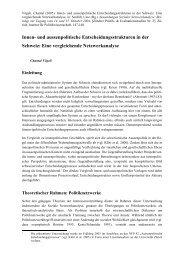Assessing Structure from Process: The Actor-Process-Event Scheme
Assessing Structure from Process: The Actor-Process-Event Scheme
Assessing Structure from Process: The Actor-Process-Event Scheme
You also want an ePaper? Increase the reach of your titles
YUMPU automatically turns print PDFs into web optimized ePapers that Google loves.
3.1 Case Study Data<br />
ACTOR-PROCESS-EVENT SCHEME - APES<br />
<strong>The</strong> case studies we are using, stem <strong>from</strong> our own case study work over the last few years<br />
and <strong>from</strong> master theses, applying APES. <strong>The</strong> following case studies are taken into<br />
investigation (cases no. 1-2 are decision-making processes on bilateral international treaties,<br />
whereas cases no. 3-4 are policy processes on a domestic issue) 2 :<br />
1. Investment Protection Agreement between Switzerland and Nicaragua, 2000 (Soland<br />
2005)<br />
2. Unemployment Insurance Agreement between Switzerland and the Federal Republic<br />
of Germany (FRG), 1982 (Klöti et al. 2005)<br />
3. Revision of the Swiss Unemployment Insurance Law, 1995 (Vögeli 2003)<br />
4. Total Revision of the Swiss Asylum Law, 1999 (Valero 2005)<br />
<strong>The</strong> active event-participation per actor can be deduced <strong>from</strong> the APES table itself,<br />
whereas the network data is derived <strong>from</strong> the APES data and calculated according the<br />
transformations mentioned above (see chapter 2.1) . Since in the current version of APES the<br />
feature of the target diagram is not completely implemented yet, we will use the software<br />
package visone (visone project team 2003) for plotting target diagrams for all four cases. <strong>The</strong><br />
target diagrams that visone suggests, show the same features as the ones provided by APES:<br />
„We (…) place vertices such that their distance <strong>from</strong> the center of the diagram is proportional<br />
to their centrality score. (...) A target diagram displays social choice within a group by placing<br />
actors inside of rings corresponding to centrality quartiles (…)” (Brandes et al. 2003:243). For<br />
our case study analysis, we will therefore import the actor-actor matrices generated by APES<br />
into the visone software application and compute the target diagrams by the means of degree<br />
centralities for all involved actors.<br />
2 In both foreign and domestic case studies, we are only interested in the domestic dimensions of the policy<br />
process, i.e., we do only consider domestic actors and their position within the policy network. Since our data<br />
has been used for publications in German, the displayed APES and target diagrams are as well labelled in<br />
German.<br />
23



